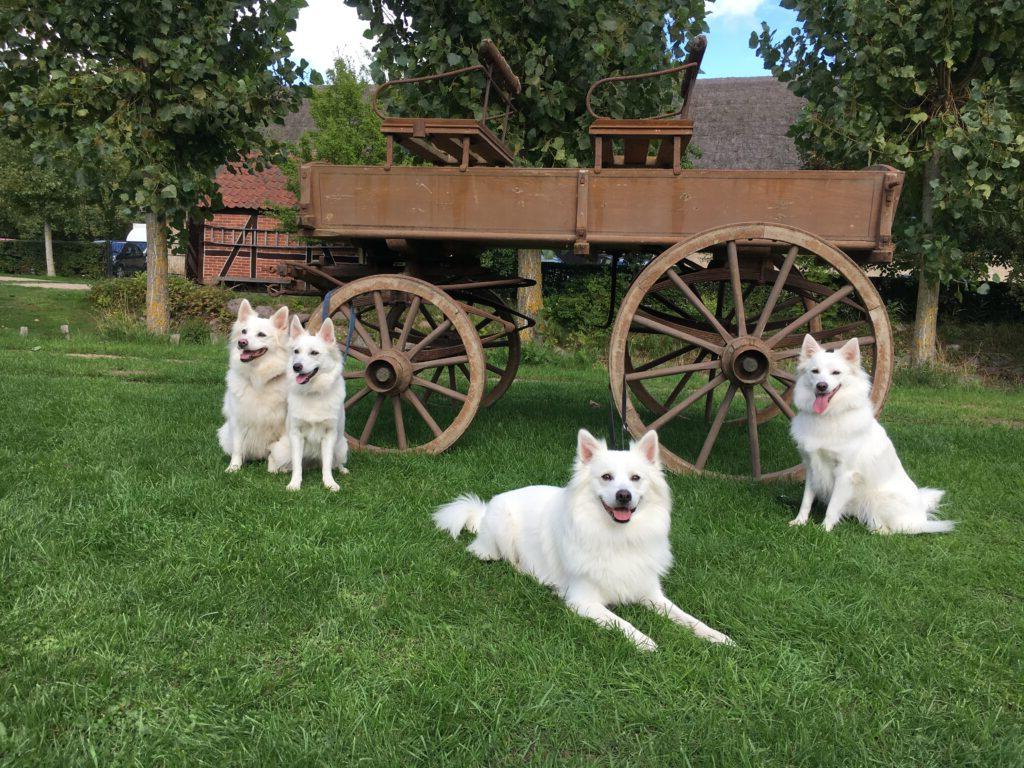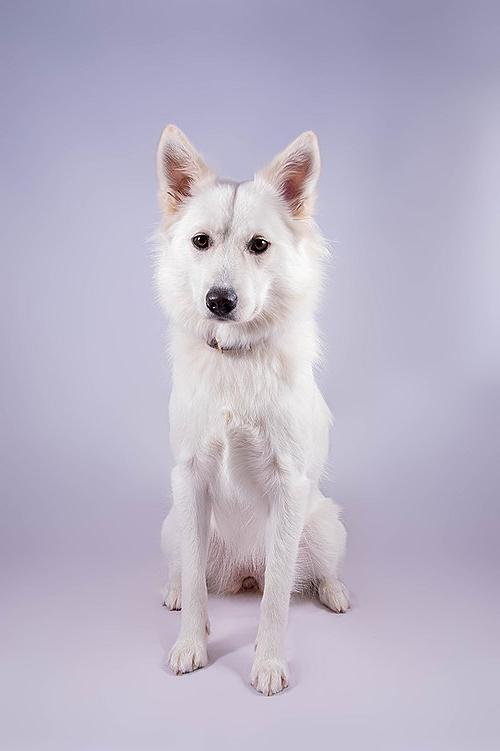- Breed Category: Companion dog
- Country of Origin: Denmark
- Average Height: 30-35 cm (12-14 in)
- Average Weight: 6-8 kg (13-18 lbs)
- Average Life Span: 12-15 years
- Grooming Requirements: Moderate, regular brushing needed
- Exercise Requirements: Moderate, daily walks recommended
- Coat Type: Double coat, dense and soft
- Coat Color Variations: White, cream, or biscuit
- Shedding Level: Moderate to high
- Ear Type: Erect, triangular
- Tail Type: Curled over the back
- Temperament: Friendly, alert, and lively
- Intelligence Level: High, quick learners
- Barking Tendency: Moderate, alert barking
- Compatibility with Children: Good, gentle with kids
- Compatibility with Other Pets: Generally good, with proper socialisation
- Training Ease: Relatively easy, responds well to training
- Common Health Issues: Hip dysplasia, eye problems
- Dietary Needs: Balanced diet, avoid overfeeding
- Energy Level: Moderate, enjoys playtime
- Drooling Tendency: Low
- Sensitivity to Weather: Sensitive to extreme heat
- Overall Maintenance Level: Moderate
- Original Purpose: Companion and watchdog
- Apartment Friendly: Yes, with sufficient exercise
- Best Suited For: Families, active individuals
- Cost of Ownership: Moderate, grooming and vet care
- Unique Traits: Spirited, fox-like appearance
Imagine a dog that combines the elegance of a fox with the charm of a teddy bear. That’s the Danish Spitz for you. This breed, with its striking appearance and lively personality, is a hidden gem among dog enthusiasts. The purpose of this article is to delve into the unique characteristics, rich history, and essential care tips for the Danish Spitz.
Originating from Denmark, this breed has a fascinating history. Once a common sight in Danish farms, the Danish Spitz was known for its versatility and companionship. Over time, its numbers dwindled, but dedicated breeders have worked tirelessly to preserve this delightful breed. Today, the Danish Spitz is cherished for its intelligence, loyalty, and spirited nature.
The Danish Spitz: A Glimpse into Its Heritage and Characteristics

Early Development of the Breed
The Danish Spitz has roots that stretch back centuries, originally thriving in rural Denmark. These dogs were invaluable on farms, adept at herding and guarding livestock. Their adaptability and keen senses made them indispensable to Danish farmers. As times changed, the breed’s numbers dwindled, but a resurgence in interest has helped preserve their lineage.
Role in Danish Culture and History
In Danish culture, the Danish Spitz holds a special place. Historically, they were more than just working dogs; they were family companions. Their presence in folklore and local tales highlights their importance in Danish society. Today, they are celebrated as a symbol of national heritage, embodying the spirit of resilience and loyalty.
Key Historical Figures Involved in the Breed’s Development
Several dedicated individuals have played pivotal roles in the preservation of the Danish Spitz. Notably, breeders in the mid-20th century recognised the breed’s decline and took action. Their efforts in maintaining breeding programs and promoting the breed have been crucial in ensuring its survival.
Physical Characteristics
The Danish Spitz is a medium-sized dog with a striking resemblance to a fox. Its thick, double coat is typically white or cream, providing excellent insulation. The breed’s pointed ears and bushy tail add to its distinctive appearance. Agile and robust, the Danish Spitz is built for both endurance and speed, making it a versatile companion.
Appearance and Unique Physical Traits
The Danish Spitz is a medium-sized dog, often drawing comparisons to a fox due to its sharp, expressive face and bushy tail. Its coat is a standout feature, usually in shades of white or cream, and is both thick and double-layered, offering great protection against the elements. This breed’s pointed ears and alert expression give it a lively and intelligent look, while its compact and agile body is built for both speed and endurance.
Temperament and Behaviour
Known for their spirited and friendly nature, Danish Spitz dogs are a joy to have around. They are intelligent and quick learners, making training a rewarding experience. These dogs thrive on companionship and are known for their loyalty to their families. While they are generally good with children and other pets, early socialisation is key to ensuring they develop into well-rounded adults. Their playful and energetic disposition means they enjoy regular exercise and mental stimulation.
Personality Traits and Suitability as a Family Pet

Typical Personality Traits
The Danish Spitz is a delightful blend of loyalty, alertness, and friendliness. These dogs are incredibly devoted to their families, always eager to please and protect. Their alert nature makes them excellent watchdogs, while their friendly disposition ensures they are welcoming to guests.
Suitability as a Family Pet
As a family pet, the Danish Spitz is a fantastic choice. Their loyalty and affectionate nature make them wonderful companions for both adults and children. They thrive in environments where they are included in family activities and are happiest when they feel like part of the pack.
Interaction with Children and Other Animals
These dogs are generally good with children, displaying patience and playfulness. However, like any breed, early socialisation is important to ensure they are comfortable around kids and other animals. With proper introduction, they can coexist peacefully with other pets.
Training and Exercise Needs
The Danish Spitz is intelligent and eager to learn, making training a relatively straightforward process. They respond well to positive reinforcement techniques. Regular exercise is essential to keep them happy and healthy, so daily walks and playtime are a must.
Training, Exercise, and Health of the Danish Spitz

Importance of Early Training and Socialisation
Getting a head start on training and socialisation is crucial for the Danish Spitz. These dogs are naturally intelligent and curious, so introducing them to various environments, people, and other animals early on helps them grow into well-adjusted adults. This early exposure ensures they are confident and adaptable, making them a joy to have around.
Recommended Training Techniques
When it comes to training, positive reinforcement is the way to go. The Danish Spitz responds well to treats, praise, and play as rewards. Consistency is key, so short, regular training sessions work best. This approach not only strengthens your bond but also keeps their sharp minds engaged.
Daily Exercise Requirements and Activities They Enjoy
These energetic dogs need daily exercise to stay happy and healthy. A good mix of walks, playtime, and mental challenges like puzzle toys will keep them entertained. They love activities that let them use their agility and intelligence, so consider games like fetch or agility courses.
Health and Lifespan
The Danish Spitz is generally a healthy breed with a lifespan of around 12 to 15 years. Regular vet check-ups, a balanced diet, and plenty of exercise contribute to their well-being. Like any breed, they can be prone to certain genetic conditions, so responsible breeding and regular health screenings are important.
Health and Care for the Danish Spitz

Common Health Issues
While the Danish Spitz is generally healthy, they can be prone to certain genetic conditions like hip dysplasia and eye disorders. Regular vet visits are crucial to catch any issues early. Keeping an eye on their weight and ensuring they get enough exercise can help prevent joint problems.
Average Lifespan and Health Tips
With a lifespan of 12 to 15 years, the Danish Spitz can be a long-term companion. To keep them healthy, provide a balanced diet rich in nutrients. Regular exercise is a must, not just for their physical health but also to keep their minds sharp. Mental stimulation through training and interactive toys can make a big difference.
Preventative Care Recommendations
Preventative care is key. Regular vaccinations, flea and tick prevention, and dental care should be part of their routine. Annual health screenings can help catch potential issues before they become serious. A good relationship with your vet is invaluable for maintaining your dog’s health.
Grooming and Maintenance
The Danish Spitz has a thick double coat that requires regular grooming. Brushing a few times a week helps prevent matting and reduces shedding. During shedding seasons, more frequent brushing is needed. Regular nail trims and ear checks should also be part of their grooming routine.
Coat Care and Grooming for the Danish Spitz
Coat Care and Grooming Routines
The Danish Spitz boasts a beautiful, thick double coat that requires regular attention. A few brushing sessions each week will keep their coat looking its best and help prevent matting. This routine not only maintains their appearance but also strengthens your bond with your furry friend.
Shedding and Seasonal Grooming Tips
Like many double-coated breeds, the Danish Spitz experiences seasonal shedding. During these times, daily brushing is recommended to manage the extra hair and keep your home fur-free. A slicker brush or a deshedding tool can be particularly effective in removing loose fur.
Diet and Nutrition
A balanced diet is crucial for the health and vitality of the Danish Spitz. High-quality dog food, rich in protein and essential nutrients, supports their active lifestyle and maintains their coat’s shine. Always ensure they have access to fresh water, and consult your vet for specific dietary needs or supplements.
Nutritional Needs and Feeding for the Danish Spitz

Nutritional Needs for Optimal Health
Feeding your Danish Spitz a balanced diet is key to their health and happiness. Look for high-quality dog food that lists meat as the first ingredient. This ensures they get the protein they need for muscle maintenance and energy. Omega-3 and Omega-6 fatty acids are also important for a shiny coat and healthy skin.
Foods to Include and Avoid
Include lean meats, fish, and vegetables in their diet. Avoid foods high in fillers like corn and soy, as well as artificial additives. Chocolate, grapes, and onions are toxic to dogs and should be kept out of reach.
Feeding Schedules and Portion Recommendations
Feed your Danish Spitz twice a day to maintain their energy levels. Portion sizes depend on their age, weight, and activity level, so consult your vet for personalised advice. Always provide fresh water alongside meals.
Fun Facts and Trivia
Did you know the Danish Spitz was once a favourite among Danish farmers for their herding skills? Despite their small size, they have a big personality and are known for their agility and intelligence. This breed is also celebrated for its resilience, having bounced back from near extinction.
Interesting Tidbits and Famous Danish Spitz Dogs
Interesting Tidbits about the Breed
The Danish Spitz, with its fox-like appearance, is not just a pretty face. This breed is known for its incredible versatility. Historically, they were used for herding and guarding, showcasing their intelligence and adaptability. Despite their small size, they have a big bark, making them excellent watchdogs. Their thick double coat, while beautiful, also serves a practical purpose, providing insulation against harsh weather conditions.
Famous Danish Spitz Dogs in Media or History
While the Danish Spitz may not be as widely recognised in media as some other breeds, they have made their mark in Danish history. These dogs were once a staple on Danish farms, and their presence in local folklore and tales speaks to their cultural significance. In recent years, efforts to preserve the breed have brought them back into the spotlight, with dedicated breeders and enthusiasts celebrating their unique qualities.
Final Thoughts
The Danish Spitz is a charming and versatile companion. With its rich history and spirited nature, this breed offers both loyalty and intelligence to its owners. While they require moderate grooming and exercise, the rewards of having such a devoted and lively pet are immense. Embracing the Danish Spitz means welcoming a piece of Danish heritage into your home, complete with its unique traits and endearing personality. Consider adopting a Danish Spitz to experience the joy and companionship they bring to any family.
